Digital Textile Printing Market Size
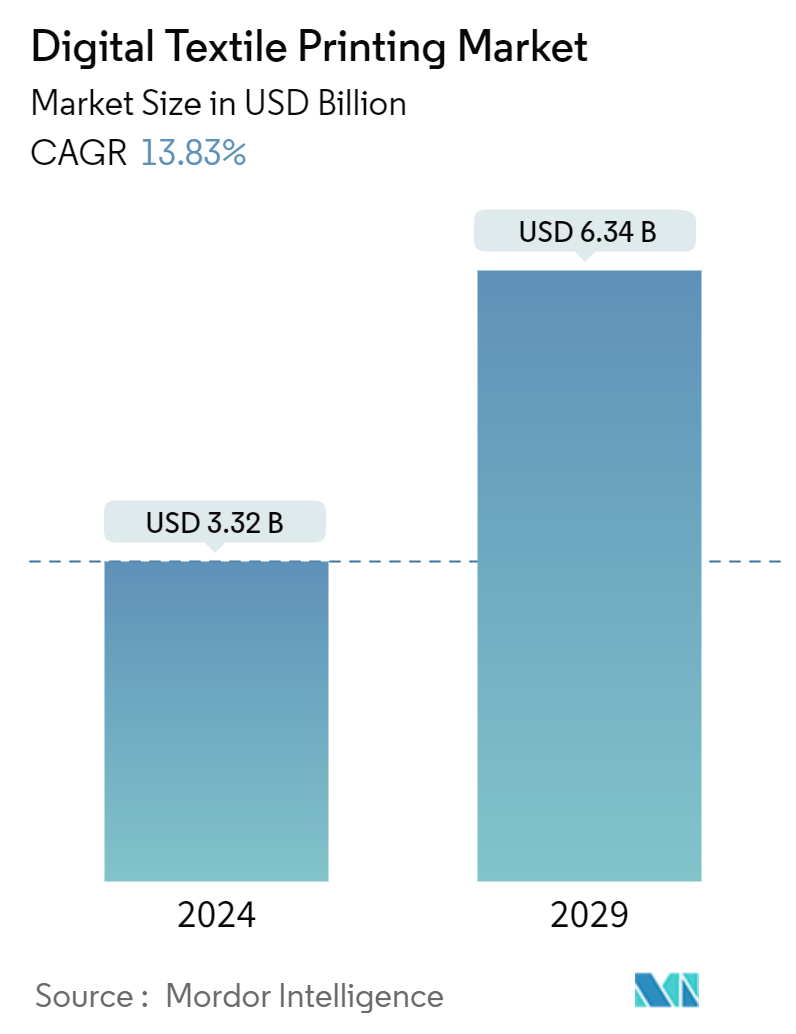
| Study Period | 2022 - 2029 |
| Market Size (2024) | USD 3.32 Billion |
| Market Size (2029) | USD 6.34 Billion |
| CAGR (2024 - 2029) | 13.83 % |
| Fastest Growing Market | Asia-Pacific |
| Largest Market | Europe |
Major Players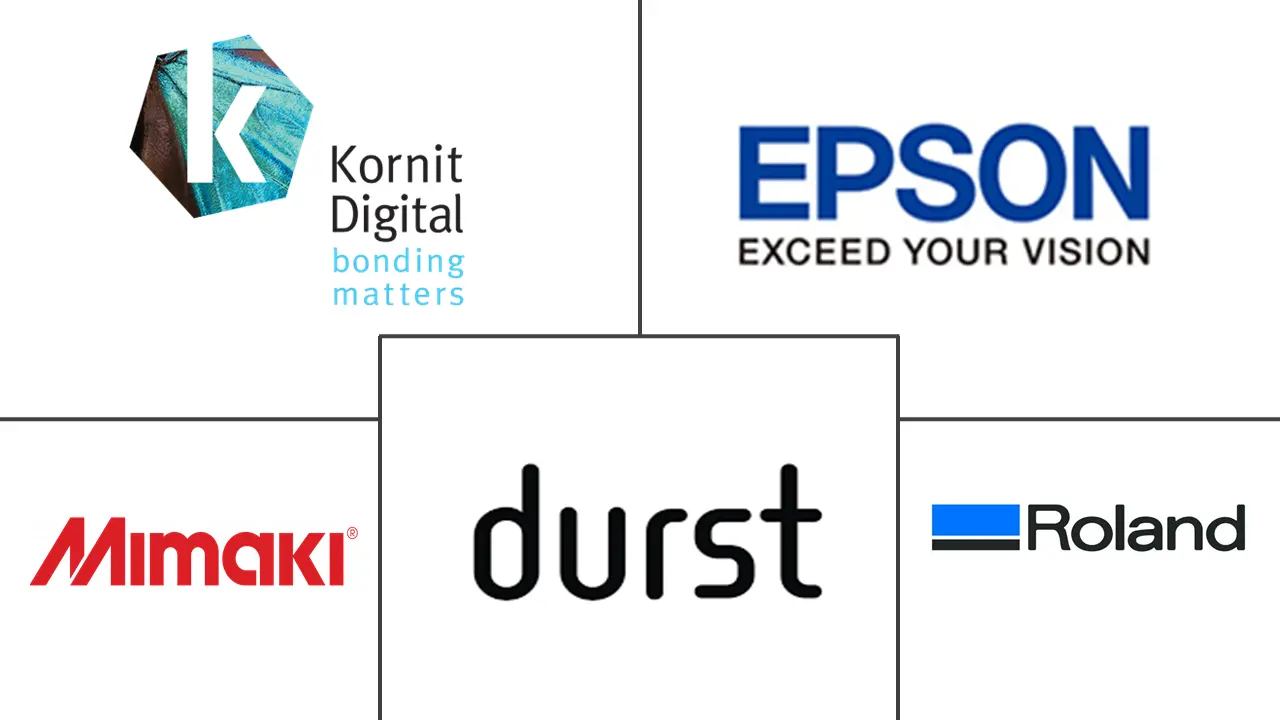
*Disclaimer: Major Players sorted in no particular order |
Digital Textile Printing Market Analysis
The Digital Textile Printing Market size is estimated at USD 3.32 billion in 2024, and is expected to reach USD 6.34 billion by 2029, growing at a CAGR of 13.83% during the forecast period (2024-2029).
- Digital textile printing, powered by inkjet technology, embellishes materials with vibrant patterns. This method, bolstered by Textile Design Software, caters to the surging demand for custom t-shirt printing, offering an array of design possibilities. Beyond the apparel sector, digital textile printing has found extensive applications in commercial and home décor markets.
- Compared to conventional methods like offset and solid ink printing, digital printing employs gentler chemicals and solvents. The textile printing market is witnessing a surge in demand for digital solutions, driven by a dual focus on eco-friendly practices and cost-effective production.
- Furthermore, advancements such as UV gel technology are driving industry innovation. For example, in May 2024, Canon USA Inc., a prominent player in digital imaging, expanded its M-series UVgel Printer's capabilities through a firmware update, building on the success of its Colorado M-series launched the previous year. This move aims to broaden application horizons, potentially tapping into new market segments.
- The use of printed fabrics gains traction in vehicle wrapping and interior decoration as the market is poised for growth. Challenges, such as the high ink costs and maintenance expenses associated with digital printers, also exist. These factors, coupled with the volatility in raw material prices, notably ink and print heads, could impede the market's expansion. However, the market's growth is buoyed by promising technologies like textile additive manufacturing.
- Despite the promising landscape, hurdles remain. High ink costs and the need for multiple printing heads in high-speed single-pass machines, coupled with their pricey maintenance and replacement, render them less competitive against rotary printing in the textile market.
Digital Textile Printing Market Trends
The Garment and Apparel Segment is Expected to Hold Significant Share in the Market
- Since its inception, garment and clothing printing techniques have advanced significantly. The most recent printing method for apparel and accessories is digital textile printing. Digital fabric printing transfers designs or images kept in a digital format into the fabric using computer-controlled printers. Designers and makers may produce complex patterns quickly and simply due to technology.
- The market for textile printing has traditionally placed a high priority on sustainability and textile waste. According to the United Nations, the fashion industry is heavily reliant on digital technology, which contributes approximately 10% of global greenhouse gas emissions.
- Due to shifting the textile design process domestically, digital textile printing has increased the speed of production and lowered shipping expenses, which enables designers to make smaller fabric test runs and waste less while finalizing the fabric, which also reduces excessive waste in the design process.
- Moreover, with cutting-edge digital textile printing technology, most digital textile printing businesses in China have begun to build advanced digital textile printing equipment in response to the demand for limitless color combinations and color accuracy.
- Furthermore, demand for digital textile printing solutions in the garment and apparel segment is expected to be anticipated to increase due to changing consumer behavior, increased urbanization, faster adaptability, shorter life cycles of fashion designs, and higher disposable income during the forecast period.
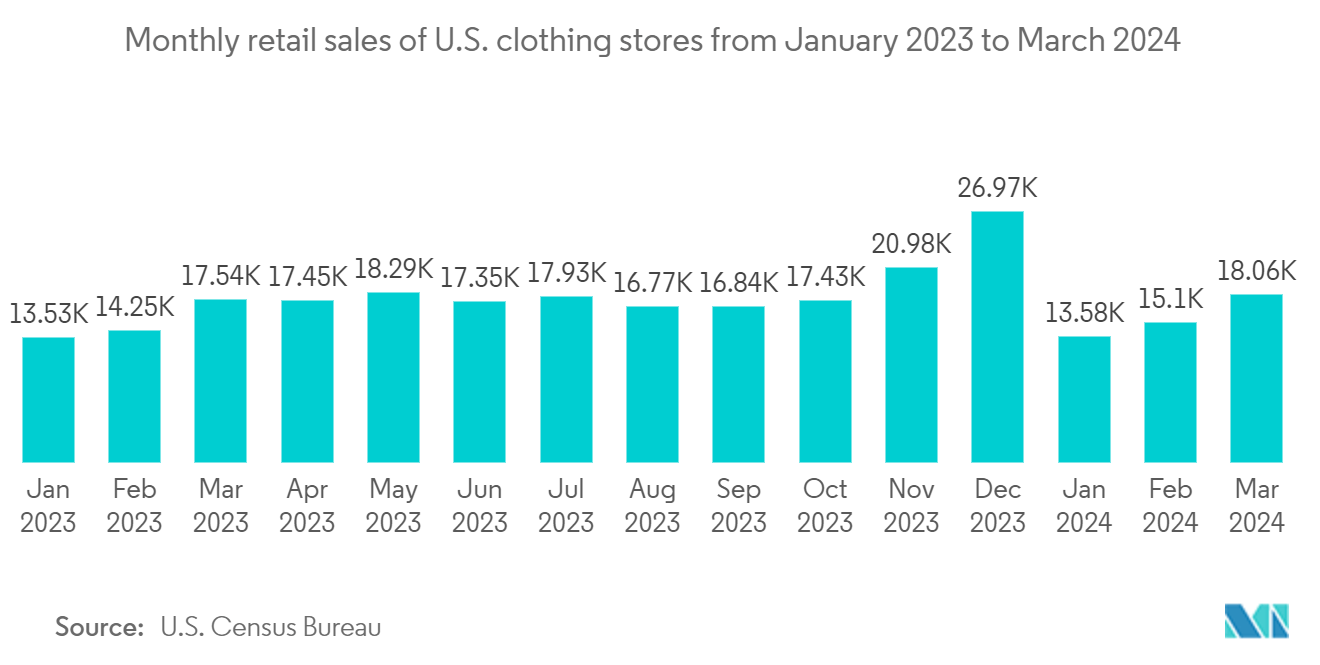
Asia-Pacific is Expected to Witness the Highest Growth
- Asia-Pacific, driven by its numerous textile hubs, is poised to lead global growth. China and India stand out as the region's primary market drivers, with Vietnam and Bangladesh emerging as key players in the textile landscape.
- China and India, known for their competitive labor costs, have witnessed a surge in textile industry expansion, propelling the market's growth in the region. China, a textile powerhouse for decades, is now focusing on enhancing its capabilities, investing in advanced technologies like shuttle-less looms to elevate fabric quality.
- Polyester has emerged as the go-to fabric for sublimation ink, especially in the fashion realm, owing to its attributes such as wrinkle and abrasion resistance and cost-effectiveness. While silk remains a coveted choice for apparel and home decor, premium pricing limits its widespread adoption in the region, with Japan and Gulf nations leading in demand for silk textiles.
- Digital textile printing and dye-sublimation technologies have revolutionized the textile production landscape, carving out new, lucrative market niches. This evolution has benefitted large format textile printers and print service providers, opening up avenues in soft signage for buildings, retail displays, and other commercial settings. The expanding fashion industry, coupled with these advancements, is set to fuel the market’s growth in the region.
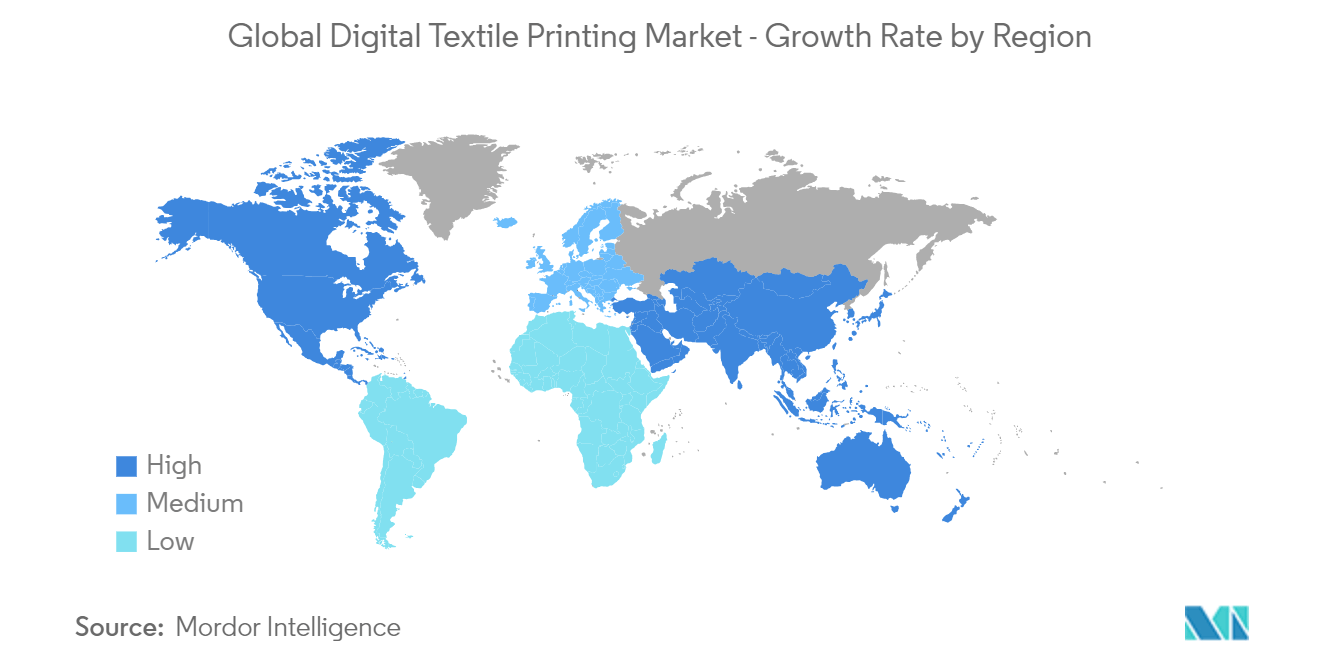
Digital Textile Printing Industry Segmentation
The digital textile printing market is witnessing heightened competition as the demand for printed textiles surges, drawing new vendors enticed by the sector's stable profitability. With a mounting preference for sustainable goods, major players are pivoting toward product innovation and strategic collaborations. Notable market players encompass Kornit Digital, Seiko Epson Corporation, Mimaki Engineering, Durst Group, and Roland DG Corporation.
- August 2024: Orange O Tec Pvt Ltd, a leading player in digital textile printing, unveiled its revolutionary "Made in Bharat" digital textile printing machine, the Fabpro 1i, at the Gartex New Delhi exhibition. This launch signifies a significant shift for Orange O Tec, which, after 15 years of importing digital textile printing machines, emerges as a prominent manufacturer in the industry.
Digital Textile Printing Market Leaders
-
Kornit Digital
-
Seiko Epson Corporation
-
Mimaki Engineering
-
Durst Group
-
Roland DG Corporation
*Disclaimer: Major Players sorted in no particular order
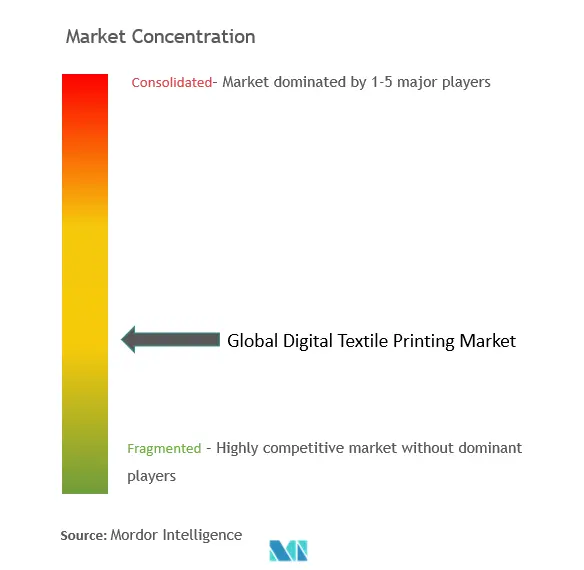
Digital Textile Printing Market News
- July 2024: Epson, a global leader in professional printing technology, collaborated with the ASEAN Fashion Designers Showcase (AFDS) to debut the ASEAN International Fashion Week (AIFW) at Singapore's renowned ArtScience Museum. Teaming up with 11 AFDS designers, Epson's Runway Show highlighted the essence of sustainable fashion powered by Epson's cutting-edge digital textile printing technology. The showcase featured exclusive designs from each designer on August 1, 2024, all crafted with precision using Epson's state-of-the-art SureColor series printers, including the F6430, F9430H, and F10030 models.
- February 2024: APPPEXPO 2024 showcased the latest in textile digital printing, solidifying its reputation as a global leader in the sector. The Shanghai International Digital Textile Printing Expo, APPPEXPO, is renowned for its fusion of creativity and technology. It is a hub for unveiling innovations and highlighting the forefront of digital textile printing. The event actively promotes international cooperation with a diverse range of exhibitors and industry trend-focused seminars.
Digital Textile Printing Market Report - Table of Contents
1. INTRODUCTION
- 1.1 Study Assumptions and Market Definition
- 1.2 Scope of the Study
2. RESEARCH METHODOLOGY
3. EXECUTIVE SUMMARY
4. MARKET INSIGHTS
- 4.1 Overview of Textile Printing
- 4.2 Technology Developments
- 4.3 Industry Value Chain Analysis
-
4.4 Industry Attractiveness - Porter's Five Forces Analysis
- 4.4.1 Threat of New Entrants
- 4.4.2 Bargaining Power of Buyers
- 4.4.3 Bargaining Power of Suppliers
- 4.4.4 Threat of Substitute Products
- 4.4.5 Intensity of Competitive Rivalry
5. MARKET DYNAMICS
-
5.1 Market Drivers
- 5.1.1 Growth of Personalization of Clothing Items in the Fashion Industry
- 5.1.2 Direct to Garment Printing
- 5.1.3 Reduction in Per Unit Cost of Printing with Digital Printers
-
5.2 Market Challenges
- 5.2.1 High Initial Investments
- 5.2.2 Ink and Substrate Compatibility
- 5.3 Impact of Microeconomic Factors on the Market
6. MARKET SEGMENTATION
-
6.1 By Printing Method
- 6.1.1 Roll-to-Roll printing
- 6.1.2 Direct-to-Garment Printing
-
6.2 By Type
- 6.2.1 Sublimation
- 6.2.2 Pigment
- 6.2.3 Reactive
- 6.2.4 Other Types (Acid, etc.)
-
6.3 By Application
- 6.3.1 Garment and Apparel
- 6.3.2 Household
- 6.3.3 Display and Signage
-
6.4 By Substrate
- 6.4.1 Cotton
- 6.4.2 Silk
- 6.4.3 Polyester
- 6.4.4 Other Substrates
-
6.5 By Geography
- 6.5.1 North America
- 6.5.2 Europe
- 6.5.3 Asia-Pacific
- 6.5.4 Latin America
- 6.5.5 Middle East and Africa
7. COMPETITIVE LANDSCAPE
-
7.1 Company Profiles
- 7.1.1 Kornit Digital
- 7.1.2 Seiko Epson Corporation
- 7.1.3 Mimaki Engineering
- 7.1.4 Durst Group
- 7.1.5 Electronics For Imaging Inc.
- 7.1.6 D.Gen Inc.
- 7.1.7 Aeoon Technologies GmbH
- 7.1.8 Roland DG Corporation
- 7.1.9 Ricoh Company Ltd
- 7.1.10 ColorJet
- 7.1.11 ATP Color
- 7.1.12 SPG Prints
- *List Not Exhaustive
8. INVESTMENT ANALYSIS
9. FUTURE OF THE MARKET
** Subject To AvailablityDigital Textile Printing Industry Segmentation
Digital textile printing is a straightforward technique that involves using customized inkjet technology to print designs directly onto fabric.
The digital textile printing market is segmented by printing method (roll-to-roll printing and direct garment printing), type (sublimation, pigment, reactive, and other types), application (garment and apparel, household, and display and signage), substrate (cotton, silk, polyester, and other substrates), and geography (North America, Europe, Asia-Pacific, Latin America, and Middle East and Africa).
The market sizes and forecasts are provided in terms of value (USD) for all the above segments.
| By Printing Method | Roll-to-Roll printing |
| Direct-to-Garment Printing | |
| By Type | Sublimation |
| Pigment | |
| Reactive | |
| Other Types (Acid, etc.) | |
| By Application | Garment and Apparel |
| Household | |
| Display and Signage | |
| By Substrate | Cotton |
| Silk | |
| Polyester | |
| Other Substrates | |
| By Geography | North America |
| Europe | |
| Asia-Pacific | |
| Latin America | |
| Middle East and Africa |
Digital Textile Printing Market Research FAQs
How big is the Digital Textile Printing Market?
The Digital Textile Printing Market size is expected to reach USD 3.32 billion in 2024 and grow at a CAGR of 13.83% to reach USD 6.34 billion by 2029.
What is the current Digital Textile Printing Market size?
In 2024, the Digital Textile Printing Market size is expected to reach USD 3.32 billion.
Who are the key players in Digital Textile Printing Market?
Kornit Digital, Seiko Epson Corporation, Mimaki Engineering, Durst Group and Roland DG Corporation are the major companies operating in the Digital Textile Printing Market.
Which is the fastest growing region in Digital Textile Printing Market?
Asia-Pacific is estimated to grow at the highest CAGR over the forecast period (2024-2029).
Which region has the biggest share in Digital Textile Printing Market?
In 2024, the Europe accounts for the largest market share in Digital Textile Printing Market.
What years does this Digital Textile Printing Market cover, and what was the market size in 2023?
In 2023, the Digital Textile Printing Market size was estimated at USD 2.86 billion. The report covers the Digital Textile Printing Market historical market size for years: 2022 and 2023. The report also forecasts the Digital Textile Printing Market size for years: 2024, 2025, 2026, 2027, 2028 and 2029.
Digital Textile Printing Industry Report
Statistics for the 2024 Digital Textile Printing market share, size and revenue growth rate, created by Mordor Intelligence™ Industry Reports. Digital Textile Printing analysis includes a market forecast outlook to 2029 and historical overview. Get a sample of this industry analysis as a free report PDF download.



